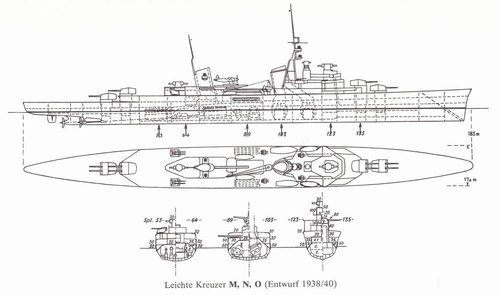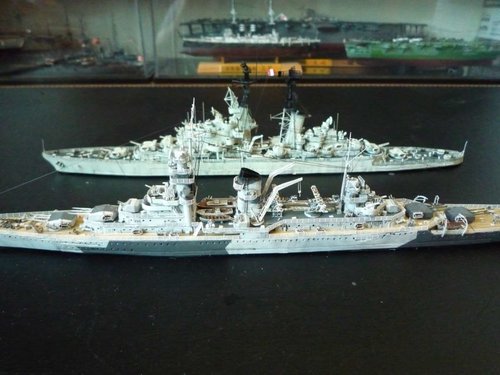The earlier British Leander seems more useful, cost efficient and had better AA (Though after refit) and armour. I disagree that the battleships had to deal with the cruisers, their job to deal with the enemy battleships.
I.
Battleship deals with everything within reach; it's written in its name. The battle is no knight tournament in this regard. In Jutland, neither British battleships spared German light cruisers, nor German battleships spared British armored cruisers just because they weren't capital ships anymore.
This is one of the key distinctions between (1)light forces/long-range reconnaissance (which fends for itself and fights for itself - no help will come) and (2)battlefleet screen/tactical recon(which fights off light/asymmetric threats, and either torpedoes or runs away from anything it can't: in the vicinity there are ships that make all direct opposition meaningless). The best protection from BB fire is being small and nimble; the best way to spend money on the battle capability of a fleet cruiser is to not spend, and save any excessive money for the battleship ... or light forces.
This equation is more complicated for ships intended primarily to screen large ships - but Ms quite clearly weren't those. They're nothing more and nothing less than a scouting extension of pre-Z KM heavy ships, by necessity operating without any light screen; it just wasn't achievable even in theory before plan Z.
The ability to overpower anything lighter than them and reasonable independence in the open ocean came in handy.
II.
Leander(and especially La Galissonniere) is an interesting comparison,
but.
(1)Leanders are purpose-built trade protection cruisers, i.e. a very different mission goal. Their corresponding fleet cruiser was the Arethusa class. Leanders' supposed German counterpart was Leipzig(with more or less comparable range/speed, ~6k@13kn) - and as we know, it utterly failed as a long-range raider/scout. It certainly could not work as a cruiser accompanying heavy ships penetrating into the Atlantic.
(2)Leanders were really a whole decade older; later ships of this period grew larger simply because of the ever-growing equipment margins. Especially since RN cruisers tended to be very spartan in this regard (not all Leanders got a proper DCT setup as built, while M has two fully-developed independent groups!). They weren't 35-knot designs, too, and that did come at a price. 1940 Agano (and Agano Kai) doesn't impress with size to guns ratio, either.
2.1 somewhat later(and more lavishly equipped) Amphion group was also very close in size, yet still much slower.
(3)Proper contemporaries for M-class are:
1. De Grasse - a universal design (both fleet and trade warfare). Very attractive if unproven, but it placed
a lot of design effort in areas opposite of that Germans intended. Probably worth pointing out, that it was either it (and La Galissonniere) or newer French Oceanic C-Ts (Mogador and later) that were seen as reference opponents.
2. Dido - British fleet cruiser. Much smaller&slower, with DP armament, and expressly meant to perform screen duties. From a German perspective, this design doesn't work (slow, range/speed). May be unpopular - but due to overly heavy DP guns - it didn't work that well for RN either. Pride aside, Arethusas were just better in all regards. Better and more successful.
2.1 Crown Colony (Fiji group). British trade warfare cruiser(really a universal one, like D-G above) stuffed the Japanese way into 8500 Dst. Super impressive design, and those famously did
a lot of fleet cruiser job (to be fair, so did the Towns). But it wasn't because they were meant to, and design priorities, again, a lot of opposites from that oceanic scout shall aim for.
3. Atlanta - US fleet cruiser/DD flagship. Similar class, but within the class - literally opposite priorities (DD leader with armament similar to them, strong emphasis on screening and AA).
4. Agano - Japanese fleet cruiser/DD flagship. Similar class, but a DD leader - explaining differences in their design. M wasn't.
III.
AA, at least in theory, wasn't supposed to matter all that much for ships designed very specifically for Oceanic action; it was indeed a mistake, but not an unique one.
For German units operating the way M was meant (i.e. quite deep in the Atlantic), their own AA really became a problem exactly once - and that once was the whole home fleet chasing down Bismarck for her crimes; expecting to fight off consequent air attack by fleet carriers is too much for a light cruiser. Otherwise, there was not much of an expected air threat far enough from the French&colonial coast, and what of it was there was potentially negatable through the effort of KM's own carrier force.
We aren't in a Pacific, where dozens of land-based long range torpedo planes can navigate many hundreds of miles straight into the open ocean, find their target there, attack it, and return. Not sure many in Europe even considered it's possible at all. Phillips didn't, and British Empire paid for it with its crown jewel.
And while it was indeed a mistake of judgment (
meaning to operate somewhere doesn't mean you'll be
only there), a rather spacey and weight-conservative design could get more equipment and AA when needed(Leander/Arethusa upgrades). Contemporary Fijis had to land guns to achieve that, and while super strong for their size - were always compromised by their extreme crampedness and lack of margins.




